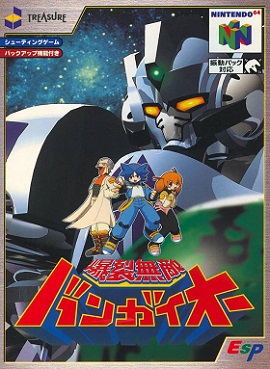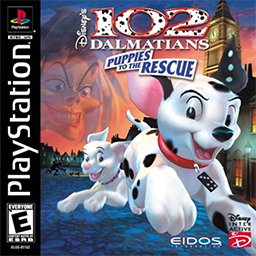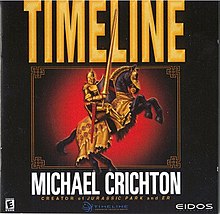
Deus Ex is a 2000 action role-playing game developed by Ion Storm and published by Eidos Interactive. Set in a cyberpunk-themed dystopian world in the year 2052, the game follows JC Denton, an agent of the fictional agency United Nations Anti-Terrorist Coalition (UNATCO), who is given superhuman abilities by nanotechnology, as he sets out to combat hostile forces in a world ravaged by inequality and a deadly plague. His missions entangle him in a conspiracy that brings him into conflict with the Triads, Majestic 12, and the Illuminati.

Bangai-O is a multidirectional shooter developed by Treasure and released in 1999 on the Nintendo 64 in Japan. It was ported to the Dreamcast worldwide shortly after with some gameplay changes and updated graphics and audio. The game places the player in control of a weaponized mech that can hover across large stages and fire at enemies all around them. The player must reach the end of each stage and defeat the boss, while avoiding hazards scattered across the map such as enemy mechs and gun turrets.

Phantasy Star Online is an online role-playing game (RPG) developed by Sonic Team and published by Sega in 2000 for the Dreamcast. It was the first successful online RPG for game consoles; players adventure with up to three others over the internet to complete quests, collect items and fight enemies in real-time action RPG combat. The story is unrelated to previous games in the Phantasy Star series.

Lara Croft is a character and the main protagonist of the video game franchise Tomb Raider. She is presented as a highly intelligent and athletic British archaeologist who ventures into ancient tombs and hazardous ruins around the world. Created by a team at British developer Core Design that included Toby Gard, the character first appeared in the video game Tomb Raider in 1996.

Midtown Madness is a 1999 racing game developed by Angel Studios and published by Microsoft for Microsoft Windows. The demo version was released in April 1999. Two sequels followed, with Midtown Madness 2 released in September 2000 and Midtown Madness 3 released in June 2003 for the Xbox. The game is set in Chicago; the object is for the player to win street races and obtain new cars.

Dungeon Siege is an action role-playing game developed by Gas Powered Games and published by Microsoft in April 2002, for Microsoft Windows, and the following year by Destineer for Mac OS X. Set in the pseudo-medieval kingdom of Ehb, the high fantasy game follows a young farmer and her companions as they journey to defeat an invading force. Initially only seeking to warn the nearby town of the invasion of a race of creatures named the Krug, the farmer and the companions that join her along the way are soon swept up in finding a way to defeat another race called the Seck, resurgent after being trapped for 300 years. Unlike other role-playing video games of the time, the world of Dungeon Siege does not have levels but is a single, continuous area without loading screens that the player journeys through, fighting hordes of enemies. Also, rather than setting character classes and manually controlling all of the characters in the group, the player controls their overall tactics and weapons and magic usage, which direct their character growth.

Hitman: Codename 47 is a stealth video game developed by IO Interactive and published by Eidos Interactive for Microsoft Windows in November 2000. In the game, players control Agent 47, a genetically enhanced human clone who is rigorously trained in methods of murder. Upon escaping from his testing facility, 47 is hired by the International Contract Agency (ICA), a global contract killing organization. His missions take him to locations in Asia, Europe, and South America to assassinate wealthy and decadent criminals, who at first seem to share no connections with each other, but are soon revealed to have all played a role in a larger conspiracy. The gameplay revolves around finding ways to stealthily reach and eliminate each target; to this end, players can make use of various tools, including disguises and suppressed weaponry. However, some levels are more action-focused and do not feature stealth as a possibility, instead playing like a traditional third-person shooter.

WWF No Mercy is a professional wrestling video game released in 2000 by THQ for the Nintendo 64. It is based on the World Wrestling Federation and is named after the company's annual event of the same name. Developed by Asmik Ace Entertainment and AKI Corporation, No Mercy is the last in a series of Nintendo 64 wrestling games from the companies that started with WCW vs. nWo: World Tour.

Sea Dogs (Корсары) is a 2000 Russian role-playing video game for Microsoft Windows, developed by Akella and published by Bethesda Softworks. In it, the player is the captain of a ship and can serve as a privateer to a European power, or as a pirate. The game uses a custom 3D game engine and includes gameplay similar to Sid Meier's Pirates!, while also being a true inter-character dialog-centered RPG.

Fighting Force is a 1997 3D brawler developed by Core Design and published by Eidos. It was released for PlayStation, Microsoft Windows, and Nintendo 64 on 15 October 1997. Announced shortly after Core became a star developer through the critical and commercial success of Tomb Raider, Fighting Force was highly anticipated but met with mixed reviews.

Tomb Raider: Chronicles is an action-adventure video game developed by Core Design and published by Eidos Interactive. It was first released for PlayStation, Windows, and Dreamcast in 2000, then on Mac OS the following year. It is the fifth installment in the Tomb Raider series. The narrative continues from Tomb Raider: The Last Revelation with archaeologist-adventurer Lara Croft presumed dead, and three friends recall adventures from her early career. Gameplay follows Lara through linear levels, solving puzzles and fighting enemies. Some levels incorporate additional gameplay elements such as stealth.

Tomb Raider: The Last Revelation is an action-adventure video game developed by Core Design and published by Eidos Interactive. It was first released for PlayStation and Microsoft Windows in 1999, then on Dreamcast and Mac OS the following year. It is the fourth instalment in the Tomb Raider series. The narrative follows archaeologist-adventurer Lara Croft as she races to imprison the Egyptian god Set after accidentally setting him free. Gameplay features Lara navigating levels split into multiple areas and room complexes, fighting enemies and solving puzzles to progress.

Zeus: Master of Olympus is a single-player strategy game developed by Impressions Games and published by Sierra Studios. It is considered to be an additional installment in the City Building series of games. Like previous titles in the series, Zeus focuses on the building and development of a city in ancient times. The game features a number of changes from previous titles in the series, including being set in Ancient Greece as well as changes to certain gameplay mechanics; however, it is considered to be in most aspects very similar to its predecessor, Caesar III.

Sheep is a strategy puzzle video game released for PlayStation, Microsoft Windows and Game Boy Advance. In 2001 it was released for Mac OS X by Feral Interactive. The Game Boy Advance version was supposed to be released in North America in the spring of 2002, but was canceled for unknown reasons.

Mister Mosquito, spelled Mr Moskeeto in PAL regions and known in Japan as Ka, is a video game developed by ZOOM Inc. for the PlayStation 2 (PS2) video game console. The game was first released in Japan by Sony on June 21, 2001, and the following March in other territories as part of the Eidos Interactive "Fresh Games" label.

MechWarrior 4: Vengeance is a vehicle simulation game, developed by FASA Interactive and published by Microsoft. It was released on November 22, 2000. It is the fourth game in MechWarrior series. It takes place in BattleTech universe where the pinnacle of all war machines are huge, heavily armed robots called BattleMechs. The player pilots one of these "'Mechs" and uses variety of available weapons to battle enemy 'Mechs, tanks and other vehicles. An expansion pack, MechWarrior 4: Black Knight, was released in 2001, and a subsequent stand-alone expansion, MechWarrior 4: Mercenaries, was released on November 7, 2002. Two smaller expansions, Inner Sphere Mech Pak and Clan Mech Pak, were also released in 2002.

Disney's 102 Dalmatians: Puppies to the Rescue is a 2000 platform game developed by Toys for Bob and published by Eidos Interactive for Microsoft Windows, PlayStation, Dreamcast and Game Boy Color. It is loosely based on the live-action Disney movie 102 Dalmatians.

The Emperor's New Groove is the name of two video games based on the 2000 Disney movie of the same name, one developed by Argonaut Games for the PlayStation and Microsoft Windows and the other by Sandbox Studios for the Game Boy Color.

The Mummy, known in Japan as Hamunaptra: Ushinawareta Sabaku no Miyako, is a single-player video game for Game Boy Color, PlayStation and Microsoft Windows, based on the 1999 movie of the same name. It was published by Konami.

Freedom: First Resistance is a third-person action-adventure video game for PC. The game was published by Red Storm Entertainment and released in the United States on 12 December 2000. The game is based on Anne McCaffrey's trilogy of novels titled the Catteni Series.




















